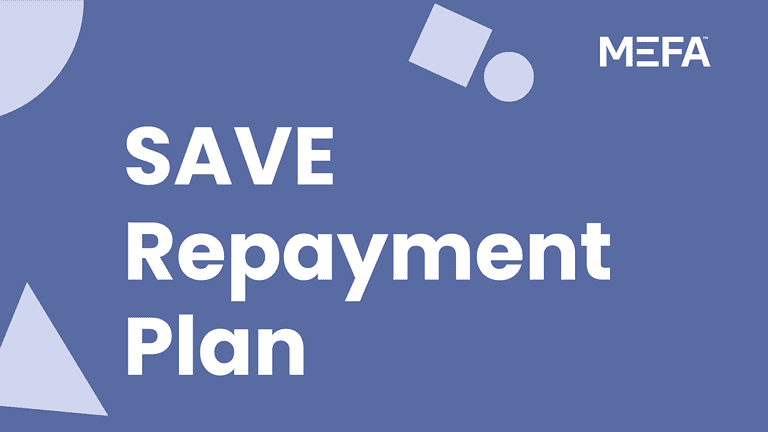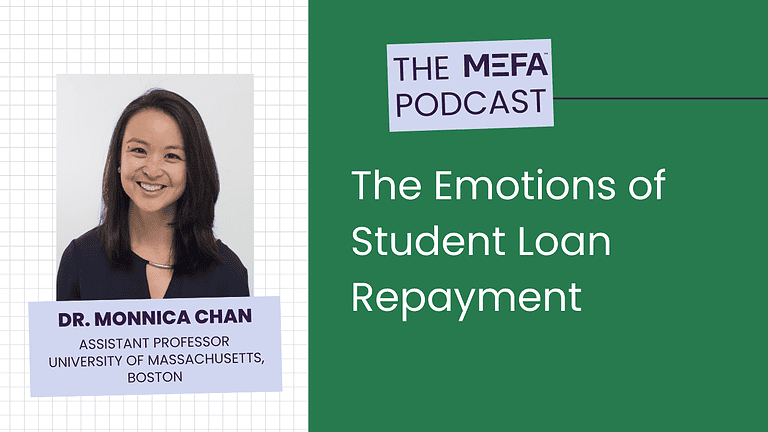It’s important to stay on track with repayment of your student loans. This webinar, recorded in April 2024, provides guidance for creating a budget, information on maintaining good credit, a smart plan for student loan repayment, and helpful websites.
Download the webinar slides to follow along.
Please note that this transcript was auto-generated. We apologize for any minor errors in spelling or grammar.
[00:00:00] All right. Good afternoon, everybody. Congratulations. You’re in the homestretch, about to graduate from college. It’s very exciting. And, uh, the less exciting part is probably the loan payments that you’re going to need to make. But today we have a lot of great information to share with you about budgeting and loan repayment, forgiveness, repayment options, all of that good stuff.
So we have a lot of material today. So it’s all important though. So we will, uh, get started. So, a little bit about MEFA and who we are. We’re a quasi state authority here in Massachusetts. We were created in 1982 to offer a low cost loan program. Since then, we’ve gone on to offer college savings plans, guidance and education for families, and even the attainable goals.
savings plan for folks with disabilities for saving for their resources. So lots of great free resources at MEFA, including MEFA Pathway, which is the College of Career Web Portal. So we have a lot of, a lot of [00:01:00] resources at MEFA, but today we’re going to focus on helping you understand your loan repayment options.
So here’s all the things we’re going to talk about. I told you we have a lot to get through. So we’re going to go through loan repayment tips. We’re going to start off today with budgeting. So the first steps in having successful loan repayment is to make sure that you are on a budget. Now, for most college seniors at this point in your life, you might not need a budget.
So for me, when I was at that age, I Spent what I earned on my weekly expenses and waited till I got the next paycheck to spend some more. Um, and you know, save a little bit for your car payment or whatever other bills you might have. But once you graduate and you start, start accumulating a little bit more bills, a little bit more rent, maybe car payments, maybe having to pay your cell phone bill, insurance.
Usually a year or two after graduation is when my parents started giving me the insurance payments and the AAA [00:02:00] payments and all those things they were covering for me, but I didn’t realize I would have to pay for it at some point. So it is good to create a post graduation budget based on your current income and current expenses.
And use a tool that’s going to work best for you. For some people, it might be a spreadsheet. For others, there’s lots of great apps out there. Um, and that might be, you know, a good way for you to keep track of your budget. But at the end of the day, really what a budget is doing is making sure that you don’t spend more than you’re taking in.
Because once you start spending more than you’re taking in, that’s when you start utilizing higher cost types of debt, such as credit cards and things like that, to pay for those expenses. So you want to identify all the sources of income that you have, and that’s going to change over time. Hopefully that will continue to grow, go up, especially as you start your career.
But most students starting out after college, if you’re getting, if you have a job, it’s likely going to be an entry level type [00:03:00] salary depending on the business you’re in. It could be different amounts. Um, but just know that as, as you get older, hopefully your pay will keep going up. Um, and that will make things a little bit easier to start saving, uh, more for rainy day funds and things like that.
We’ll talk about, but the first thing that you really want to do as you’re As you’re looking at, uh, you know what you’re doing with your money is distinguished between needs and wants. And that’s very, very important. Do you need that new sweater or do you want that new sweater? You know, do you need a new car or can you get by with the car you have for a couple more years with no car payments?
To try and, you know, get, get a foot up, um, finance wise, it really is, you know, when you’re looking at expenses and things you want to do, whether it’s going to a concert or going on a vacation and money’s tight and you might not have the money to pay for that, you really want to say to yourself, do I need this or do I want it?
Um, you need to get your car fixed to get to work. If you don’t have the money for [00:04:00] that, you might be using a credit card, but you don’t, it’s not a want, that is definitely a need. So you really want to start thinking about that. If you’re having trouble trying to keep track of where’s my money going, what am I spending my money on?
One, one thing I did a long time ago when I was looking at budgeting my money was I kept track of every penny I spent for a month. And I, you know, put it into different categories on a spreadsheet to see where’s my money going. Is it really that Dunkin Donuts coffee that they tell you not to buy once a day?
And, you know, you add up how much that’s going to cost over a year. Is that’s what’s holding you back? Or, you know, are there other, you know, things that you’re splurging on that you might not need to splurge on as much? Um, I found myself splurging a lot on, you know, self care and trips to CBS. You can go in for one thing and end up coming out with a whole basket full of stuff you probably don’t need, but you want.
So little things like that. So identify all your bills and [00:05:00] expenses and leave some wiggle room for unexpected bills and expenses. And you won’t going to want to revise those as needed.
So in order to understand what you have in student loan debt, especially your federal student loans, you want to visit studentaid. ed. gov. That is where you will log in with your student aid account, which can also be called your FSA ID. So for some of you, you may have your FSA ID. FSA ID that you use to fill out the FAFSA.
Well, that’s also the same login for your studentaid. ed. gov account. That’s where you can find all the information about your federal loans, how much you borrowed each year. Your loan servicer should be on there. If you borrowed any private loans, such as a loan through MEFA or Sallie Mae or, you know, any other lender.
Those aren’t going to be on the federal government’s website, but any federal loans, even federal consolidation loans would be [00:06:00] on there. So you’re going to find your private loans information on the private loan lender website. So you’ll want to find out who is your loan servicer, not just for your federal loans, but also for your private loans, because you want to know that is the organization.
that you’re going to be making your payments to. If you need to defer, if you need to do a forbearance, if you need a different repayment option, you need guidance on choosing a repayment option, that is the company you’re going to be working with until that loan is paid off. So your loan servicer, they’ll be able to obviously tell you when your first payments due, but also the amount.
And most loan servicers these days, just with most financial companies, usually have apps. and pretty user friendly websites to make this whole process just a little bit easier. I definitely recommend, you know, if you, you, if you like doing everything on your phone, which most of us do these days, you want to, you know, download the app for your federal loan servicer.
It’ll be really handy.[00:07:00]
Now with your private loans, if you borrowed any private loans, whether you’ve done it on your own or more likely with maybe parents as a co signer, if you’re not sure who you borrowed from or. Where, where those loans are, you can always check in with your financial aid office because they’ve certified those loans.
So they should know where you’ve borrowed through. Uh, but most of you, you know, you should know at least who the lender is. And then each lender that some lenders may service their own loans. Most lenders usually outsource the servicing of their loans. So for example, with MEFA, we have a loan servicer that we utilize to help families with students with paying back their MEFA loans.
It’s still a MEFA loan. We own the loan, but we hire a company to service it for us. And a lot of lenders will do that. So just keep in mind, if you have a loan through a lender, you might be making your payments through a loan servicer that has a different name and website, but you’ll be able to find that out from your lender as well.
And [00:08:00] your loan servicer is obviously the company that you’re going to be working with closely to make your payments. So for your um, private loans, you’re, you want to create an account. You can do that anytime to create an account once it’s sent over to the loan servicer so that at least you have access to that account even if you don’t have payments due just yet.
Download that app. Add those loan payments now to your monthly budget, even if you’re not making the payments. So that way, usually there’s a six month grace period and you start making your payments then. Then you’ll know, okay, what do I need to prepare for so I can add that into my budget and make sure that come time payments are due, that you’re prepared to make those payments.
Because you don’t want to be kind of blindsided on November of 2024 when your federal loans go into repayment and not have a plan to pay. So you just want to start thinking about that now. And put an item on your [00:09:00] calendar maybe 30 days before your payments due. Just to give yourself a reminder. Okay, I gotta remember.
Set up that auto debit for my student loan payments. Now typically if your loans were deferred you’ll have what’s called a grace period and that’s a time in between graduation or whenever you leave school when your payments due. Your first payment is due. If you have a private loan it may or may not have So if you’ve been in a deferred loan, so you’re maybe your parents are paying those loans now, and maybe they want you to help paying back later, but really right now, let’s just focus on, you know, some of the federal federal loan repayment options.
So when you’re gathering information you want to understand all the different options for repayment. Okay, most students will have a standard 10 year repayment and you’ll be set up on that, but there are other options which we’re going to cover today. You also should notate what is the interest rate on each loan, in each loan’s total [00:10:00] balance currently, when you start putting all this information together.
Because if you have a little extra money, one month, and you want to put it towards one of your bills, one of your debts, whether it be a credit card or car payment or student loan, you kind of want to know, okay, what are the interest rates on all the debt that I have? Start paying back if you have extra payments beyond the minimum payment, whatever debt is the highest interest rate.
Get rid of that first, start paying that down first, and then work your way down. Typically, most folks who have any kind of debt, their credit cards have the highest interest. So you want to try and get rid of that credit card debt first. If you have extra money to put towards your debt. Now once you do start having to pay back your loans, it’s critical that you make your payments on time.
At least the minimum payment. If you can’t make more than the minimum payment, you know, and this goes for any bill really that you have, that’s okay for that month. Just at least make the minimum payment so [00:11:00] that you’re on time and it doesn’t affect your credit. Using auto debit is a really great way to make any payments for any of your bills.
As long as you have the money in your checking account so that you don’t even have to think about it. The money comes out of your checking account. It’s paid and it’s on time every month. Again, you do have to have money in your checking account to pay that bill, or else that payment will bounce and it won’t get paid.
But as long as you have the appropriate money in your account, those payments will be made on time. And it also just saves you the hassle of having to go on an app or go online and make a payment each month, or even send a check if you’re still sending out checks. If your family or you have a 529 college savings account, maybe you didn’t utilize it all for college, you can actually use up to 10, 000 of that to pay off your federal student loans in total.
So that’s another use of funds if your family does have a little bit of extra 529 money left over. [00:12:00] And again, as I mentioned, pay the highest debts off first, whether it’s your student loans, car payment, or credit card. And once you are in a situation when you can start paying down your student loans, you can tell your loan servicer to put any extra payments towards principal.
The payment that you have that’s due is always going to pay, you know, any interest that’s due first and the rest will go towards principal. So as you go further on in your payments, it’ll be more towards principal and less towards interest as you get towards the end of repayment and paying off those debts.
So making your payments on time with all of your debts, no matter what it is, is really critical to maintain good credit. Excuse me.
Now, good credit, I’ll go over that in a minute of why it’s so critical, but it’s going to affect everything in your life. Every purchase that you make, whether it’s a car, even applying for an apartment, [00:13:00] a lease on an apartment, Even jobs might be looking at your credit. If you’re applying for a job to see what your credit score is looking like to see are you paying making your payments back on time that so that credit score is really important for you to understand and keep track of.
And typically you can find that credit. So if you want to buy a home, you’re going to need to have a credit score on your credit card statements. A lot of credit cards are now providing that information. And I have some resources at the end of other, you know, web websites and apps that you can use to track your credit score.
But your credit is going to determine your interest rate on future purchases. So if you want to buy a home. If you want to buy a car or whatever it might be, typically when it comes to those purchases, even, you know, taking out a private loan for graduate school, your credit score is going to usually determine your interest rate.
So the higher your credit score, the lower your interest rate and vice versa. So if you have a [00:14:00] higher credit score, if you can start building that up by making on time payments. That’s going to be the quickest, easiest way to get towards a good credit score is making your payments on time. That’s one of the biggest factors in creating, in determining a credit score, is on time payments.
Now, bad decisions, not just bankruptcy, which is, you know, the, the Probably the most difficult, um, financial repercussion, but even just, you know, one payment, 30 days late, six, two months late, you miss a payment for two months, that’s going to go in your credit report. And that’s going to stay there for seven years before it falls off.
Now, the further you are away from any bad credit decisions, whether it be, you know, a default, a bankruptcy or late payments, it becomes less and less of an impact on your credit score, but it is still on there for seven years affecting your credit. So credit can go up, but it can also go down pretty quickly.
Um, so you do want to keep an eye on that. I [00:15:00] monitor my credit every month. You can actually, um, review your credit report, which all the information on your credit report is really what calculates your credit score to make sure all of that is accurate. Make sure that the loan amounts are correct, that who you borrowed through is correct.
There’s no, You know, identity theft on there and somebody didn’t, you know, purchase something with your credit card number or something like that, you do want to take a look at your credit report, even if it’s just to understand what’s on a credit report. If you haven’t done that yet, I definitely recommend you do that.
It’s very eye opening, has a lot of information about you, your history of where you’ve lived, employers, things like that. That’s all going to be on your credit report.
Okay, so once you’ve done all of that, you want to definitely be in touch with your loan servicer if you have any issues. If, if your loan servicer is calling you, there’s a reason. [00:16:00] Maybe your payments due or maybe they have questions about a deferment, um, on your loan or whatever it might be, you Don’t be shy about picking up the phone.
If your loan services trying to contact you, they are trying to help you make payments on time and establish good repayment habits. So work with them. If you can’t make your payment on time, especially, you know, with your federal loans, there’s lots of options that we’ll talk about. Um, even with your private loans or even a credit card, try and give them a call to maybe work out a payment.
repayment option plan, and see what your options are there. But if you have any questions, don’t, don’t hesitate to reach out to your loan servicers. And depending on your income, you may, especially in the earlier stages of your career, where you might be below the income threshold, you may be able to deduct your student loan interest on your federal taxes.
So if you’re doing your own taxes, let’s say on TurboTax, you’ll see that as one of the questions that they ask.[00:17:00]
Okay, so feel free to type those questions in the Q& A and my colleague will be answering those and he’ll stop me if there’s a good question that we want to answer for the whole group. And we’ll definitely leave time, we’ll have time at the end for Q& A as well. Alright, so let’s focus on your federal loan repayment options.
Most students who have borrowed any type of education loan have federal student loans. When we’re talking to families earlier in the game about borrowing, we always recommend that they borrow federal loans first before any other type of borrowing, whether it be parent loans or MEFA loans. Because the federal student loans do have a lot of good benefits that you’re just not going to find with any other type of private loan.
For your student, federal student loans, everybody is put initially into the standard. 10 year repayment option. So you’re making your payments the same payment for 10 years. There are other options where you can extend your [00:18:00] repayment or change your payments so that it’s a little bit smaller when you first start making payments.
We’ll go through those options, but there are lots of great options. If that month, if that 10 year plan is too expensive for your budget, Call your loan servicer, get guidance on the options that are available to you, um, because you might be able to go into another repayment option that has a little bit lower payment.
Maybe it’s a extended to a 15 year plan or whatever it might be. We’ll go through them. There’s lots of options here to think about now, but just know that if you do push out the payments or do lower payments up front, it’s going to have a higher overall cost because you’re not paying down that principal as much initially.
Um, but You know, if it’s going to help you stay on budget and make your payments on time, then that’s worth, that’s worth the cost there because you can always, you know, try and double up payments later when you can afford it and maybe reduce that cost on your own. So [00:19:00] studentaid. gov has a loan simulator, which you can go online and you can plug in your information to look at the different options to see what’s going to work best for you.
You can do this at any time, um, just to try and start, you know, creating a budget and creating a plan. So, here are the repayment options that are currently available. Now, there’s a lot of them, as you can see. So, let’s go through them. So, I mentioned the standard repayment option, 10 years. There’s also a 10 year plan called the graduated repayment option, where you make lower payments initially, maybe the first three years, then your payments go up for another three years.
And then you sort of have a much larger balloon payment at the end for the last four, three to four years of your repayment. So this can be useful to keep yourself within that 10 year plan so that you’re paying it off in 10 years, keeping that cost down. But it helps you when you’re first getting started to have a [00:20:00] little bit lower payment on your.
Federal loans that typically will have a lower interest rate than credit card debt, for example, or even maybe a Carlin. Now, there’s also extended repayment where you have fixed payments or graduated payments. There’s different options. You have to have, um, 30, 000 minimum and you can extend it up to 25 years.
So that will definitely reduce your payment a lot and that might be, you know, something that’s worth it for you. Now the repay save plan for, for those of you on the line, that, that plan is going to be replaced in a month or two in June of 2024 by the save plan. So I won’t spend too much time going through repay because it’s going to be replaced by save.
Um, but the pay plan that is also, you know, new students are not going to be able to get on that plan after July. So students who are using the pay plan are going to be [00:21:00] able to use that for the rest of their repayment. But basically, between the two, it’s really looking at your, your income, your discretionary income and Making a payment that it’s a certain percentage in this case, 10 percent of your income so that folks who might not be making a lot of money right out of college that might be able to get you a lower payment.
So you really want to kind of run the numbers, work with your loan servicer about all these options and see which one’s going to work best for you. There’s also the income based plan. Excuse me, where payments are 10 or 15 percent of your discretionary income, and after 20 or 25 years, if there’s anything left over, that debt is forgiven.
Income contingent, similar concept, payments are the lesser of 20 percent of your discretionary 20 Or a 12 year fixed plan. Um, the, of what it would be, your payment would be for a 12 [00:22:00] year fixed plan. And then that loan debt is forgiven after 25 years. So we’re saving the best for last. If you can’t do the 10 year plans, which, you know, are going to help you pay it off sooner and save the most, the save plan, which is going to be new in June of 2024.
Is going to be probably a good option for a lot of folks. I’m going to go through that in a little bit more detail for undergraduate loans. That is a much lower percentage of your discretionary income, only 5%. So you can see the difference from the other plans we talked about. If you have graduate loans, it will be up to 10.
It will be 10 percent of your discretionary income. That’s what your payment will be. So the same plan is fairly new, and that’s going to Be one of the better plans that most students will probably end up with because it does have a lot more benefits. So your direct loans. Most of you probably don’t have any federal, um, FFEL loans.
Most of you have [00:23:00] direct federal loans. And so those are the loans that you can use the save plan with. So until July 2024, right now it’s 10%, but after July 2024, it’ll be 5 percent of your discretionary income is going to be your payments. Or if it’s a graduate loan, it’ll be 10%. of your graduate loans.
Borrowers who have a combination of undergrad and graduate loans will have a weighted average. And the other nice thing about this plan is that if you’re married your spouse’s income is excluded. Excuse me, if you’re filing your taxes separately. And your spouse is also not included in the family size when determining, um, your family size based on federal poverty guidelines.
So let’s go through it in a little bit more detail. With this plan, with the SAVE plan, you have a maximum of 20 years [00:24:00] for your undergraduate debt to pay off that loan, and 25 years for graduate debt. There’s no income threshold or eligibility for this. These loans that are in this payment option are eligible for public service loan forgiveness.
And we’ll talk about PSLF in a minute. So there’s no cap on the payment amount. So if you have a higher income, 10 percent of your income might even be higher than the standard 10 year plan. So just be prepared for that. Uh, and your income is verified annually in a new payment amount is calculated annually based on your income.
So just be prepared that you’ll need to get that verified annually. An unpaid interest is forgiven monthly. There’s no negative amortization on that. So here’s some examples of, um, a payment option. Payment [00:25:00] options. For a student who has 40, 000 in debt, just so you can kind of get an understanding and a general idea of what those payments will be looking like.
So she borrowed 20, 000 in unsubsidized direct loan and 20, 000 in subsidized at an interest rate of 5. 5%. And I did take a sneak peek. Um, the all of these plans, I took a sneak peek at the questions. All of these plans, whether it’s a subsidized loan or an unsubsidized loan are eligible for these plans. So the only difference between the subsidized loan and the unsubsidized loan.
So it’s all the same direct loan. It’s just that subsidized portion was interest free while you’re in school. So no interest is accumulating while you’re in school on that subsidized portion. Once you graduate, all of your loans are unsubsidized, meaning interest is going to start occurring on all of it, not just the unsubsidized portion.
[00:26:00] So this student or this, uh, professional Victoria, she’s 40, she has 45, 000 income, single lives in Massachusetts and her income. increases at a rate of 5 percent a year. So if you look at the different options, and again, you’ll get these slides, you can take a peek at as you go, but the standard repayment for Victoria is going to be 434 over 10 years, and that’s not going to change.
And you can see if you look at the column that says total paid in interest, that has the lowest amount because you’re paying it off sooner than all the other repayment options. But if that 434 is just too much to take on for her, especially with her salary at 45, 000, adding in rent and utilities and food and all those other expenses, she’s going to be accumulating.
She might want to look at other repayment options, so I’m just going to skip. I’ll just look at the graduated one because I mentioned that one earlier. It starts at a much lower payment. [00:27:00] Initially, it’s still 10 years of repayments, but you can see that final payment is 741, so it is something to think about and just be prepared if you’re looking at graduated repayment of that balloon payment at the end.
Now save I know I mentioned that plan is going to be, you know, probably good for a lot of students, 102 a month and then ends up at 520 a month. So a little bit more than the standard 10 year plan, but you can see that the interest that’s accumulating on that loan is much higher. But if it’s a matter of making that minimum payment and Okay.
Being on time then that might be worth, you know, keeping good credit to make those, uh, Smaller payments and a little bit more in interest over the life of that loan
So there are income driven plans that we’re that we’ve been talking about that have. Um, Formulas based on loan debt and [00:28:00] income and borrowers are always going to pay the lesser of the two So these are just acronyms if we look at income contingent income based repayment You can see the percentage of discretionary income that the federal government is looking at for you to pay on those different repayment plans.
And then you can see the payment based on the loan debt. So whether it’s a 10 year amount, um, with the repay and save, it’s 10 percent discretionary income, 5 percent if it’s undergraduate for save, So they do have calculators on the federal department’s website that I mentioned that loan simulator and your loan services should have calculators as well to help you kind of run the numbers and play around with the numbers there.
Now I’m going to switch, switch gears and talk a little bit about private loan repayment, but I’ll first check, check in with Sean and see if there’s any federal loan repayment option [00:29:00] questions that we should answer now before we move forward. I think we’re good stuff. I’m answering the questions. Okay, great.
Thank you.
Okay. So private loans are loans that you and your family may have borrowed above and beyond your federal direct student loans. So MEFA would be 1 example. I mentioned Sally May. Um, there’s all kinds of private lenders out there. Now, you don’t have the same federal benefits with private loans that you do with your federal student loans.
So some of you may even remember during the pandemic with your federal student loans, there was additional benefits where it was interest free. There was no interest being assessed for a couple years during the pandemic. Um, so things like that just don’t really happen with, you know, private loans outside of the federal government.
So you do want to kind of look at those individually. Make sure you know who you borrowed from, who the loan servicer is, what their website is, and what’s going to be on your billing [00:30:00] statement. Make sure that your email address is up to date. You don’t want to be using your college email address that’s going to be turned off when you graduate or you might not have access to those emails.
Make sure you have a separate email, like a gmail for example. Private loans typically Typically, you’re choosing your repayment option when you first borrow the private loan. So, for example, with MEFA, we have five repayment options to choose from. You choose that when you’re approved and you take out the loan.
And that’s going to be your repayment option for the life of that loan. So, there might be limited repayment options to choose from, because you’ve already chosen your repayment option up front. And then deferment, typically, if you chose a deferred payment for your private loan, then the payments are going to be deferred while the student’s in school.
And typically once they graduate, the loan will go into repayment, usually about six months later. So you can contact, again, I encourage you to contact your loan servicer with any questions you [00:31:00] have about your repayment. Okay, so let’s talk about forgiveness options. Forgiveness is when your balance that you have at the time of forgiveness is basically wiped out.
Clean slate. You don’t have to pay whatever’s left over at forgiveness. So some are, you know, for some students, all or or a portion of their loans are forgiven. There’s a couple reasons why that could happen. And really, I’m focused on federal student loans here when we’re talking about forgiveness.
Student loan forgiveness typically occurs either for doing something good, maybe working in a public service field, such as public service loan forgiveness, or relief if something, you know, something bad should happen, such as, um, you know, fraud or something like that. So we’ll talk about that. For the reward side, some of the common forgiveness plans that you might have heard of or be interested in looking up could be public service loan forgiveness, [00:32:00] teacher forgiveness.
There’s AmeriCorps, AmeriCorps, most of you probably don’t have Perkins loans, but if you’ve been in school for, you know, five, six, seven years, you may have a Perkins loan. So there are options there. The one that’s probably getting the most press and, you know, has a lot of students that might qualify is public service loan forgiveness.
So I just want to focus on that one a little bit. All of these are laid out in fine detail on studentaid. gov, so you can check out all the forgiveness options there that I just mentioned, but let’s talk about PSLF a little bit more deeply. So with PSLF, the payments, your, whatever your balance is, is forgiven.
After 120, so 10 years of qualifying monthly payments. Now, they don’t have to be 10 consecutive years. You do have to be working in full time capacity for an employer during that repayment [00:33:00] and it has to be a government organization. 501c3 or for a not for profit or other non profit qualifying company that’s providing qualifying services and you can find that out on studentaid.
gov as well, but so, you know, if you’re working in this kind of field, for example, your social worker or your work, your police officer, um, you know, typically a lot of folks in those fields might be eligible for PSLF. So let’s say you start out, um, you know, I’m just going to make this up a social worker, you do 10 year, five years of repayment and that job and you decide, okay, I’m going to try something new for a year and get a new job that might not qualify that a new employer might not qualify for PSLF.
So you have five years under the social work job, get that new job, work there for a couple years and decide, I really loved social work. I want to go back into that field. So then you just have to do another five years under that [00:34:00] qualified employer. It doesn’t have to be the same employer of, and then you’ll get your 10 years of qualified payments.
So my point here is that it doesn’t have to be 10 consecutive years. It could be five years here, another two years here, and another, you know, three years later. It just has to be, the payments have to be made under that qualifying employer to qualify for PSLF. Only direct federal student, only direct loans qualify.
Only payments made after October 1st of 2007 qualify. And you can submit your PSLF application after making all 120 payments. So there’s a tool right here studentaid. gov forward slash PSLF that can help you with understanding this a little bit better. Um, and you can check that out as well, especially if you’re looking at a public service field.
But again, it will be a while before you’ll be eligible for this, but. You know, if you looked at those other repayment options, we talked about extending [00:35:00] your payment option beyond 10 years. At the end of 10 years, you might have a balance to be forgiven. So you want to kind of think about that as part of your overall repayment strategy as well.
If you’re going to be one of the students that might qualify. A couple other common plans, teacher loan forgiveness, teaching full time, five complete consecutive years. So those do have to be consecutive depending on where it has to be in a certain area, school or agency that serves low income families.
Again, that’s only the federal Direct loans, Stafford loans, and up to 17, 500 can be forgiven for this. So you can find that application on studentaid. ed. gov. So you can say, I keep saying this website over and over again, because all of your resources, everything we’re talking about is on there. And then most of you probably don’t have Perkins loans, but there is forgiveness, um, for that as well.
So some other reasons [00:36:00] beyond, you know, on time payments that you might qualify forgiveness or, or loan discharge. Could be total and permanent disability of the students. Death of the student or borrower. God forbid, uh, maybe the school violated a law. So you may have heard in the news, you know, some for profit colleges that didn’t, um, you know, meet their obligations to their students.
So some of those students have had their loans forgiven by the federal government. Were the school closed while the student was enrolled? If the student isn’t able to find a new place to go, you know, there’s a lot of caveats here with this one. Um, so you can check that out and, uh, free student loan advice has some good options there as well.
Dot org to just to get more guidance on this. All right, anything we need to stop for right here, Shauna, should we go into the consequences of not making payments? [00:37:00] No, you can move ahead, thanks. Okay, thank you for covering the questions behind the scenes. All right, so deferment is when your loan payments are postponed.
So right now, most of you, if you’re in college right now, you’re in an in school deferment. So you don’t have to make payments while you’re in school. There could be other eligibility requirements. So Peace Corps, military, there’s deferment for that. Um, and you can submit a request to your loan servicer.
Sometimes when students might switch schools or maybe, you know, you go on to graduate school in the fall, but You know, the lender doesn’t have your enrollment updated yet. You might get a bail for your loan coming up, um, let’s say in October, but if you’re in school, you can have still have your loan deferred as long as you’re enrolled, you know, certain period of time.
So interest is not going to accrue on your subsidized loans during this period. Now forbearance is a [00:38:00] little bit different. You still don’t make payments during forbearance, but it’s really asking the. Service or to suspend or reduce your payments. You have to meet certain eligibility requirements. Um, you know, let’s say you’re not working and you can’t make those payments.
Forbearance is an option. A lot. It’s really a last resort to make sure that you’re not getting behind on your payments that will, you know, have a negative impact on your credit interest is going to be accruing on all of these loans. However, during forbearance,
So deferment, unemployment, economic hardship, there’s all different types, um, military, in school, there’s different types of deferment, uh, forbearance, there’s other types of forbearance, such as if you’re going to medical school, you have a residency, or an internship, National Guard, so it really [00:39:00] depends on what your situation is, whether it’s a deferment or a forbearance, but either way, you don’t have to make repayment, um, payments during these periods.
And so it’s really worth it to use a deferment of rebearance if you absolutely can’t make that payment so that you’re not late on those payments. I know I keep harping on the credit score and maintaining good credit, but these are great options to help you keep that good credit if, you know, times are tough and you’re struggling to make those payments.
Now, if you’ve gone through all these options and you’re in repayment and you just don’t make the payments there are, you know, severe consequences for that on your federal student loans, not to mention, you know, any type of debt that you don’t make payments on. Delinquency begins the day after the due date.
So if your bill’s due on the 15th and you don’t have your payment made the 16th, technically you’re delinquent on that payment. Federal student [00:40:00] loan default occurs after 270 days of delinquency. So you have a long time of making no payments before your loan goes into default. So you really want to work with your loan servicer to avoid this at all costs.
Working with a forbearance or deferment, whatever the resource might be, a different repayment option to keep yourself from going into default and they can help you with that. So that is, you know, that’s their job. That’s what they want to do. They want to try and help you keep either making your payments on time or put you into a plan that’s going to allow you a little breathing room so that you’re not considered delinquent.
Keep in mind if you’re doing deferment or forbearance, it is going to cost more money and interest over the life of that loan, but it might be, you know, it’s, it’s better to do that than to be reported late. Because there are serious consequences for default on your loans. It’s going to be reported to the credit bureaus, of course.[00:41:00]
You won’t be eligible for future student aid until you get your loan out of default. So if you’re looking to go on to graduate school and you’re in default on your undergraduate school, you won’t be able to borrow for graduate school until this is cleared up. Uh, you may be required to get the loan out of default by paying the balance off in full.
Um, you may lose eligibility for some of those great repayment plans and deferment and forbearance options. We talked about collection. Agencies will be calling you. Um, you may have your wages garnished and garnishment of your tax refunds. There are also, um. You know, different, um, you know, if you want to be a lawyer or doctor, there’s different, um, regulations and, and things like that, that you might have difficulty with, um, you know, getting approved.
So you just want to keep that in mind. So I mentioned different ways to get out of default. God forbid this should [00:42:00] happen to you. You can pay that loan in full. But for most people, if they could pay the loan in full, they would have been making the payments. So, uh, you could consolidate your loan and agree to make that payment under an income driven plan.
So that’s a way to get the loans out of default. You could consolidate after making three consecutive payments. Or you could rehabilitate the loan by making nine on time payments within, you know, ten consecutive months. So there are ways to get out of default if you end up in that situation. All right, so let’s talk a little bit more about options later.
Do you have questions, Sean? Yeah, Steph, before we move on, um, we have a couple questions about If, um, a family is able to combine multiple MEFA loans into one. Yeah, so that’s a good question. If you have multiple MEFA loans, um, MEFA does have an education [00:43:00] refinancing loan. So we have consolidated billing.
So you should have all your payments in one place to make it easier. Um, but if it’s just, you know, if you want to look at refinancing your loans, you could do that. MEFA has a refinancing loan where You can refinance your MEFA loans or any other, you know, student loan debt or private loans that you may have taken out for education.
Um, so we do have that and there are other refinancing options. You can’t consolidate private loans, however. Consolidation, which we, we talked about a little bit, that’s really only for the federal loans. Where you’re combining your loans into one, whereas refinancing, you’re paying off those loans and taking out a new loan to pay off that debt.
And so you can’t, um, consolidate, uh, private loans. You can only refinance them. You can refinance federal loans as well, but we often recommend that because there’s so many benefits to the federal student loans that, that you look at maybe [00:44:00] consolidation versus refinance. Does that answer that question?
Any others that we want to stop for, Sean? Nope, that’s it. Thanks. Okay, great. All right. So let’s talk a little bit more. I mentioned consolidation refinancing. Let’s get into that a little bit. So federal loan consolidation is when you’re combining multiple federal loans into a direct federal consolidation.
So this is only for your federal loans. Um, And it can be federal student loans. If you’re a parent and you have a plus loan, you can consolidate your plus loans, but you have to be the borrower on the loan. So the new interest rate is going to be a fixed interest rate, which is a weighted average of all the loans being consolidated.
Those loans do have to be in repayment or grace period, so you can’t do them while you’re in school. And there are several repayment options available even with the consolidation loans and it will give you a repayment plan of either 10 to up 10 to up to [00:45:00] 30 years based on the debt and the repayment plan that you choose.
Now a student cannot consolidate their parents plus loan parent plus on the reason why is because they’re not on the loan only the parent is on the plus one, and you can’t as I mentioned consolidate private loans there’s no application fees. And you can take a look on student aid. gov to get more details about federal loan consolidation.
Some things to consider with consolidation will give you one bill per month, but nowadays with, you know, for all your loans are in one place and you have an app and you’re doing auto debit, having more than one loan shouldn’t be too hard to manage, but it could potentially lower your payments and access alternative payment plans.
You could take a, um, might be a variable rate loan to a fixed rate loan, but you may also lose borrower benefits if you’re consolidating loans. And you could, if you’re increasing the repayment on that loan, [00:46:00] it’s going to increase the overall cost of that loan. So just keep in mind, the further you push out payments, it might help with the monthly payment, but it is going to cost you more for the life of that loan.
Now, education loan refinancing is similar in a sense, but you’re doing it through a private lender like MEFA, for example. You can refinance both federal and private loans, but as I mentioned, you’ll lose your repayment benefits associated with your federal loans. So you really want to think twice before you refinance any federal loans.
There are lots of options available. You can shop around. Um, typically some lenders offer fixed and variable rates. MEFA offers just the fixed rate, but you’re basically paying off those loans and, um, taking out a new loan with one rate, a bigger balance. So that new interest rate is going to be based on your current situation.
So your current credit score, they’re going to be looking at credit [00:47:00] scores, uh, lenders, we’re going to be looking at your income. You’re going to have to do an income check. We want to make sure that you as a student can take on this education refinancing loan. So again, when we talk about good credit and why it’s important.
Good credit eats or equals a stronger financial picture, which in turn equals lower interest rates and big savings. So this might not be the option for everyone. I mean, you really want to think about if you, if you’re refinancing loans, if you have a really low interest rate right now, you might not want to refinance because that rates might be a little bit higher these days, but you can refinance really anytime during repayment.
So, what is the difference? So, federal loans are available for both consolidation and refinancing, but as I mentioned, you’ll lose federal loan benefits if you refinance them. So, be wary, be cautious of that. Private loans are only eligible for refinancing, not consolidation. There’s no credit check for consolidation, because you’re [00:48:00] really just merging loans and getting a weighted average, but with refinancing, it’s like taking on a brand new loan, so there is a credit and income check.
You may save money on both plans depending on the new interest rates that you’re taking out and the repayment option that you choose with both. You’ll get one bill, so all of that is consolidated, which might make repayment easier. But again, with, you know, most people aren’t using coupon books and checks to make payments these days, you can do it all on an app, so it should be pretty easy to at least keep track of repayment and to be making those pretty easily.
So some things to consider, you know, if you’re looking at refinancing, you’re going to have the one bill, potentially a lower interest rate. That’s one of the only really good reasons to, um, or one of the best reasons, I should say, to refinance a loan is to get is to lock in a lower [00:49:00] rate. You could potentially lower your payments if you’re extending your repayment beyond what you currently have.
And, you know, if you had, if you get a variable rate. Or even a higher cost fixed interest rate, you know, when you when you’re an undergraduate and you might be able to get a lower rate at a fixed program. Now, if you refinance. And as I mentioned, I know I keep talking about this, but increasing your repayment term increases the total cost of the loan.
Alright, so let’s go through some free resources and then we’ll end and answer some questions. So here’s some helpful websites, reputable websites that you can take a peek at. And you’re going to get these slides, so you’ll get these websites to really help you with your repayment journey. I’m just gonna point out a couple, um, MEFA.org.
Of course, if you are looking at education refinancing, student [00:50:00] aid.ed.gov has everything you need for all your federal loan repayment questions and options and forgiveness options. Uh, you can go to irs.gov to find out what the option is to redo to, um, to deduct your student loan interest payments. So depending on your income level, you do have to be below a certain income threshold.
Bankrate is a site you can go to to compare different options. Credible is also a loan comparison site. Annualcreditreport. com is a site where you can go to get your free credit report. Here in Massachusetts, you’re eligible to get one free credit report a year. And Credit Karma. It’s actually a free app.
Um, of course, you know, usually trying to sell you some, some tool or another, but it is free and your credit score is on there. I actually have the app on my phone. I like it because I like to keep track of my credit score and it does give you, it does have some really cool tools [00:51:00] that you can play around with calculators.
So if I reduce my credit card debt by 5, 000. How will that impact my credit score? Things like that. And so it does have some cool tools and Mint. com is another resource. So here’s Mipha’s social channels. We encourage you to follow us if you like podcasts, listening on your way to work, um, or in between classes, podcasts.
These videos are always recorded and listed on our YouTube channel. And we’re always sending out good information on. I still call it Twitter at X and Facebook. So definitely follow us there. And here’s our phone number and website. So if you need to reach out to us, whether you have a MEFA loan or not, if you just have questions, we’re here to help.
MEFA is a free resource for families and students. So don’t hesitate to reach out if you need help through this, uh, through this journey. All right. So with that, I’m going [00:52:00] to stop with the slides and we’ll get into some Q and a for those of you who do need to hop off. Thank you for joining us today. We will share the recording as well as the slides probably tomorrow with you.
So keep an eye out for that. All right. So what do we have? Okay. Thank you. I just got a note that mint. is combined with Credit Karma now. So I didn’t realize that. So thank you for sharing that, Jeff. Good to know. And I don’t see any other questions coming in, but I’ll just leave it open for another minute or two.
So we’ll update that slide about Mint. And thank you, Sean. I see a lot of questions that you were able to answer. All right, I think that’s it. So I’m going to end the webinar for everybody right now. So thank you for joining us and have a great day. Call us if you have questions. Thank you, everybody.













